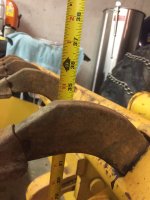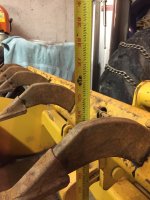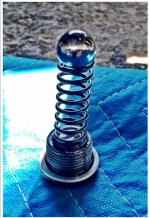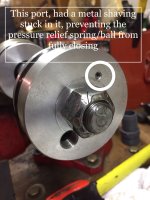Piston
Elite Member
Well, it wasn't a leaking seal.
I did replace all the seals thinking that it was the problem originally, after tearing into it the originals appeared fine. On top of that, the exact same thing was happening before and after the new seals. This pretty much ruled out the seals.
I tried bleeding the air out and functioning the cylinder numerous times. I really didn't think there was air in there but wanted to make sure.
What the problem was, was a small metal shaving (I think it was a piece of the threads that must have stripped somewhere) that got stuck in one of those really small ports that the spring/ball check valve normally closes off.
That small shaving wasn't allowing the steel ball to seat and seal the port closed. I took it out and it probably would have been fine, but I ended up JB Welding those ports closed permanently.
I put it back together and tested it out, instantly it did feel better and a lot more solid. It didn't have any give in it. I know I don't know a lot about hydraulic cylinders but I'm fairly certain that neither the seals, or air entrapment was at all a contributing factor. However, all the tips and advice pointing to those is what ultimately led me to find the actual problem.
I took a pic and video after putting it all back together....then went in for supper...
Hydraulic cylinder, no leakdown - YouTube

I just came back up to the garage to check on it, and 3 hours later it has creeped (crept?) 3/4 of an inch. I'm happy with a quarter inch per hour

I still don't understand what those small ports are for? They are a type of check valve I suppose, but looking online at parts diagrams it seems most cylinders do t even have these?
Seeing that this cylinder is never under much stress, I didn't see a need to have check valve ports protecting it.
Regardless, I'm just happy it doesn't creep down in less than 10 seconds anymore! As an added bonus, I learned quite a bit in the process.
Never stop learning. . Thanks all.
. Thanks all.
I did replace all the seals thinking that it was the problem originally, after tearing into it the originals appeared fine. On top of that, the exact same thing was happening before and after the new seals. This pretty much ruled out the seals.
I tried bleeding the air out and functioning the cylinder numerous times. I really didn't think there was air in there but wanted to make sure.
What the problem was, was a small metal shaving (I think it was a piece of the threads that must have stripped somewhere) that got stuck in one of those really small ports that the spring/ball check valve normally closes off.
That small shaving wasn't allowing the steel ball to seat and seal the port closed. I took it out and it probably would have been fine, but I ended up JB Welding those ports closed permanently.
I put it back together and tested it out, instantly it did feel better and a lot more solid. It didn't have any give in it. I know I don't know a lot about hydraulic cylinders but I'm fairly certain that neither the seals, or air entrapment was at all a contributing factor. However, all the tips and advice pointing to those is what ultimately led me to find the actual problem.
I took a pic and video after putting it all back together....then went in for supper...
Hydraulic cylinder, no leakdown - YouTube

I just came back up to the garage to check on it, and 3 hours later it has creeped (crept?) 3/4 of an inch. I'm happy with a quarter inch per hour

I still don't understand what those small ports are for? They are a type of check valve I suppose, but looking online at parts diagrams it seems most cylinders do t even have these?
Seeing that this cylinder is never under much stress, I didn't see a need to have check valve ports protecting it.
Regardless, I'm just happy it doesn't creep down in less than 10 seconds anymore! As an added bonus, I learned quite a bit in the process.
Never stop learning.


